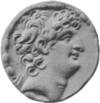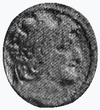| Seleucids Σελευκίδαι | |
|---|---|
| Royal house | |
 The Vergina Sun remained a principal standard of the Seleucid dynasty, although the anchor and elephant were more prevalent. | |
| Country | Syria, Persia |
| Founded | 312 BC |
| Founder | Seleucus I |
| Final ruler | Philip II Philoromaeus |
| Titles | |
| Dissolution | 64 BC |
| Cadet branches | Diodotid dynasty (Bactria)(?) |
 |
| History of Greater Iran |
|---|
| Periods and dynasties of Babylon |
|---|
|
All years are BC |
|
See also: List of kings by Period and Dynasty |
The Seleucid dynasty or the Seleucidae (/sɪˈluːsɪˌdiː/; Greek: Σελευκίδαι, Seleukídai, "descendants of Seleucus") was a Macedonian Greek royal family, which ruled the Seleucid Empire based in West Asia during the Hellenistic period. It was founded by Seleucus I Nicator, a general and successor of Alexander the Great, after the division of the Macedonian Empire as a result of the Wars of the Successors (Diadochi).
Through its history, the Seleucid dominion included large parts of the Near East, as well as of the Asian territory of the earlier Achaemenid Persian Empire. A major center of Hellenistic culture, it attracted a large number of immigrants from Greece who, encouraged by the Seleucids, formed a dominant political elite under the ruling dynasty.[1] After the death of Seleucus I, his successors maintained the empire's strength establishing it as a Greek power in West Asia;[2] the empire reached its height under emperor Antiochus III.[3] From the mid-second century BC, after its defeat at the hands of the resurgent Parthian Empire, the polity entered a state of instability with slow territorial losses and internecine civil wars. The Seleucids, now reduced to a rump state occupying a small part of Syria succumbed to the Rome's annexation of their territory in 64 BC under Pompey the Great.


























